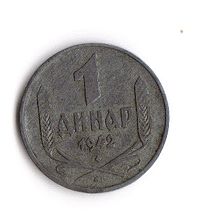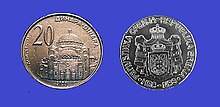Serbian dinar
| dinar | |
|---|---|
| Country: |
|
| Subdivision: | 100 para |
| ISO 4217 code : | RSD |
| Abbreviation: | Din. |
|
Exchange rate : (29 Mar 2020) |
1 EUR = 117.026 RSD 1 CHF = 108.75 RSD |

The Serbian Dinar ( Serbian - Cyrillic динар ) is the currency of Serbia . A dinar is divided into 100 Para , whereby there are no more valid Para coins.
history
A Serbian dinar was first introduced by King Stefan Nemanjić around 1214. Thereafter, Serbian kings and princes minted the dinar until the end of medieval Serbia in 1459. In addition to the dinar, there was also a sub-currency, the perper. The perper was usually a copper coin, the dinar made of silver. In the Middle Ages, having your own coin was an important symbol of state independence. With the Ottoman conquest, various currencies were then used until the mid-19th century. The Ottomans operated several mints in Serbia, such as B. in Novo Brdo in Kosovo , Kučajna and in Belgrade .
Today's hundredth of a Serbian dinar is named Para (from the Arabic bara for silver) after the last common Ottoman silver coin .
In the 19th century there were around 43 different currencies in circulation in the Principality of Serbia (about 10 gold currencies, 28 silver and 5 copper currencies). Faced with this multitude of currencies, Prince Mihailo Obrenović ordered that a national Serbian currency should be minted. The new copper coins were named Para and issued in denominations of 1, 5 and 10 Para. The front was embossed with the portrait of the prince and the year 1868.
In 1875 the silver dinar was (re) introduced. The silver dinar was worth 100 para. Silver coins of 50 para, 1 dinar and 2 dinar were minted in 1875.
The first gold coins were issued in 1879 with a value of 20 dinars.

With the coronation of Prince Milan II. Obrenović as Serbian king, the minting of gold coins was re-regulated in 1882, and the milandor ( French , "golden Milan") worth 10 dinars and 2 milandors worth 20 dinars came along.
The milandor was later abandoned and the national currency was fixed purely in the dinar and the para. These remained as national currencies in Yugoslavia.
Until 1999, both republics of the Federal Republic of Yugoslavia - Serbia and Montenegro - used the Yugoslav dinar . This was replaced in 1999 by the D-Mark in Montenegro and by the Euro in 2002 . In Kosovo , as in Montenegro, the D-Mark was used from 1999 to the end of 2001 and the euro since 2002. The Serbian dinar is still the currency in northern Kosovo .
Coins
Coins exist in the values 1, 2, 5, 10 and 20 dinars, each in different metals and with different coats of arms and state names ( Republika Srbija , SR Jugoslavija ). The 50 para coin was no longer legal tender on January 1, 2008. The subdivision into Para has thus become practically meaningless.
Since January 1st, 2010 the coins of 1, 2 and 5 dinars with the embossing “Yugoslavia” are no longer valid. However, these could still be exchanged in the branches of the Serbian National Bank until the end of 2012.
Banknotes
The first edition of the banknotes (depending on the denomination 2000, 2001, 2002) still bears the country name "Yugoslavia", from 2003 the Narodna Banka Srbije is the issuing authority. The notes with the old name “Narodna Banka Jugoslavije” have been invalid since January 1, 2007.
There were several seal variants on the back in the watermark field. The "Yugoslav" notes show a simple double-headed eagle, the following editions a stylized "double Б". The current seal (double-headed eagle in front of a crowned ermine coat) was introduced in 2005/6/7/10 and revised from 2011.
| front | Rear | value | portrait | year | year |
|---|---|---|---|---|---|

|

|
10 dinara | Vuk Stefanović Karadžić | 2000 | 2006, 2011, 2013 |

|

|
20 dinara | Petar II. Petrović-Njegoš | 2000 | 2006, 2011, 2013 |

|

|
50 dinara | Stevan Stojanović Mokranjac | 2000 | 2005, 2011, 2014 |

|

|
100 dinara | Nikola Tesla | 2000, 2003, 2004 | 2006, 2012, 2013 |

|

|
200 dinara | Nadežda Petrović | 2001, 2005 | 2011, 2013 |

|

|
500 dinara | Jovan Cvijic | 2004, 2007 | 2011, 2012 |

|

|
1000 dinara | Georg Weifert | 2001, 2003 1 | 2006, 2011 |

|

|
2000 dinara | Milutin Milanković | 2011 | 2011, 2012 |

|

|
5000 dinara | Slobodan Jovanović | 2002, 2003 | 2010 |
Web links
Individual evidence
- ^ Coins withdrawn from circulation . ( Page no longer available , search in web archives ) Info: The link was automatically marked as defective. Please check the link according to the instructions and then remove this notice. National Bank of Serbia
